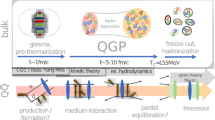Abstract
We construct a folding potential between the \(\alpha \) and \(\Lambda \) particles based on underlying nucleon-nucleon and hyperon-nucleon interactions. Starting from a phenomenological \(\Lambda \)-N potential and a Gaussian form of the \(\alpha \)-particle wave function we obtain the \(\alpha \)-\(\Lambda \) potential and with this potential the binding energy of \(^5_\Lambda \)He is (3.10 MeV), which is consistent with recent experimental data \(3.12 \pm 0.02\) MeV. When in turn an exact solution of the four-body Faddeev-Yakubovsky equation for the \(\alpha \)-particle calculated with the CDBonn, Nijmegen or Argonne V18 realistic nucleon-nucleon potential is used and the phenomenological Gaussian \(\Lambda \)-N potential is replaced by the realistic (e.g. Nijmegen NSC97f) potential approximated by a rank-1 separable form, then \(^5_\Lambda \)He is overbound. In particular, its binding energy given by the folding potential generated with the \(\alpha \) particle wave function based on the CDBonn potential is 7.47 MeV. Although the rank-1 separable \(\Lambda \)-N potential reproduces the exact scattering length and the effective range of the original \(\Lambda \)-N potential, the \(\Lambda \)-\(\alpha \) folding potential results from these \(\Lambda \)-N potential give a large binding energy of \(^5_\Lambda \)He .




Similar content being viewed by others
References
G. Alexander et al.: Phys. Rev. 173, 1452 (1968)
B. Sechi-Zorn et al.: Phys. Rev. 175, 1735 (1968)
R. Engelmann et al.: Phys. Lett. 21, 587 (1966)
J.A. Kadyk et al.: Nucl. Phys. B 27, 13 (1971)
K. Miyagawa et al.: Phys. Rev. C 51, 2905 (1995)
E. Hiyama, M. Kamimura, T. Motoba, T. Yamada, Y. Yamamoto, Phys. Rev. C 97, 881 (1997)
E. Hiyama et al.: Prog. Theor. Phys. 97, 887 (1997)
H.H. Oo, K.S. Myint, H. Kamada, W. Glöckle, Prog. Theor. Phys. 113, 809 (2005)
H.H. Oo, K.S. Myint, H. Kamada, W. Glöckle, Few Body Syst. 54, 1283 (2013)
Machleidt, R., Phys. Rev. C 63, (2001) 024001
Stoks, V.G.J., Klomp, R.A.M., Rentmeester M. C. M. and de Swart, J. J.: Phys. Rev. C 48, 792 (1993)
R.B. Wiringa, V.G.J. Stoks, R. Schiavilla, Phys. Rev. C 51, 38 (1995)
E. Hiyama et al., Phys. Rev. C 53, 2075 (1996)
J. Haidenbauer et al., Nucl. Phys. A 915, 24 (2013)
Haidenbauer, J., Meißner, Ulf-G,: Phys. Rev. C 72(4), 044005 (2005)
T.A. Rijken, V.G.J. Stoks, Y. Yamamoto, Phys. Rev. C 59, 21 (1999)
M.M. Nagels, T.A. Rijken, J.J. de Swart, Phys. Rev. D 15, 2547 (1977)
K. Tominaga, T. Ueda, M. Yamaguchi, N. Kijima, D. Okamoto, K. Miyagawa, T. Yamada, Nucl. Phys. A 642, 483 (1998)
Fujiwara, Y., et al.: Phys. Rev. C 65, 014002 (2002)
W. Glöckle, H. Kamada, Phys. Rev. Lett. 71, 971 (1993)
Kamada, H., W. Glöckle, Nucl. Phys. A 548, 205 (1992)
W. Glöckle, H. Witała, D. Hüber, H. Kamada, J. Golak, Phys. Rep. 274, 107 (1996)
W. Glöckle, The quantum mechanical few-body problem (Springer, Berlin, 1983)
H. Horiuchi, Prog. Theor. Phys. Suppl. 62, 90 (1977)
A. Gal, Adv. Nucl. Phys. 8, 1 (1975)
Afnan, I.R., Gibson, B.F,: Phys. Rev. C 92, (2015) 054608
P.M.M. Maessen, Th.A. Rijken, J. de Swart, J. Phys. Rev. C 40, 2226 (1989)
Nagels, M.M., Rijken, Th.A., Yamamoto, Y,: Phys. Rev. C 99, 044003 (2019)
Acknowledgements
We would like to thank Prof. J. Golak (Jagiellonian Uni.) for helping us with fruitful physics discussions during his visit Japan (2020). This work was supported by DAAD of Germany and partially by Grant-in-Aid for Scientific Research (B) No: 16H04377, Japan Society for the Promotion of Science (JSPS). The numerical calculations were performed on the interactive server at RCNP, Osaka University, Japan, and partially on the supercomputer cluster of the JSC, Jülich, Germany.
Author information
Authors and Affiliations
Corresponding author
Additional information
Publisher's Note
Springer Nature remains neutral with regard to jurisdictional claims in published maps and institutional affiliations.
Rights and permissions
About this article
Cite this article
Oo, H.H., Kamada, H. \(\Lambda -\alpha \) Potential by Folding \(\Lambda \)-Nucleon Interaction with Realistic \(\alpha \) Wave Function. Few-Body Syst 63, 9 (2022). https://doi.org/10.1007/s00601-021-01709-x
Received:
Accepted:
Published:
DOI: https://doi.org/10.1007/s00601-021-01709-x




